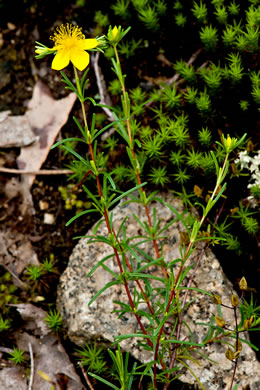Spermatophytes (seed plants): Angiosperms (flowering plants): Eudicots: Core Eudicots: Rosids: Fabids: Malpighiales
WEAKLEY'S FLORA OF THE SOUTHEASTERN US (4/24/22):
Hypericum lloydii
FAMILY
Hypericaceae
Go to FSUS key
Dig deeper at SERNEC, a consortium of southeastern herbaria.
Read more about Lloyd's St. Johnswort at Vascular Plants of North Carolina.
SYNONYMOUS WITH
PLANTS NATIONAL DATABASE:
Hypericum lloydii
FAMILY
Clusiaceae
SYNONYMOUS WITH Flora of North America
Hypericum lloydii
SYNONYMOUS WITH VASCULAR FLORA OF THE CAROLINAS (Radford, Ahles, & Bell, 1968) 126-01-012:
Hypericum lloydii FAMILY Hypericaceae
COMMON NAME:
Lloyd's St. Johnswort, Sandhills St. Johnswort, Piedmont St. Johnswort
To see larger pictures, click or hover over the thumbnails.
Keith Bradley kab_h_lloydii_2529
September Lancaster County SC
Forty Acre Rock Heritage Preserve
A dwarf shrub with 0.5-1", linear leaves (like conifer needles), per Wildflowers of the Sandhills Region (Sorrie, 2011).
WEAKLEY'S FLORA OF THE SOUTHEASTERN US (4/24/22):
Hypericum lloydii
FAMILY
Hypericaceae
SYNONYMOUS WITH
PLANTS NATIONAL DATABASE:
Hypericum lloydii
FAMILY
Clusiaceae
SYNONYMOUS WITH
Flora of North America
Hypericum lloydii
SYNONYMOUS WITH
VASCULAR FLORA OF THE CAROLINAS (Radford, Ahles, & Bell, 1968) 126-01-012:
Hypericum lloydii
FAMILY
Hypericaceae
If a search such as "Carex leptalea var. leptalea" doesn't deliver the results you want, try "Carex leptalea".
Or, to minimize chances of a misspelling, try just "Carex le".
Less is more: If "pencil flower" doesn't deliver the results you want, try "pencil".


